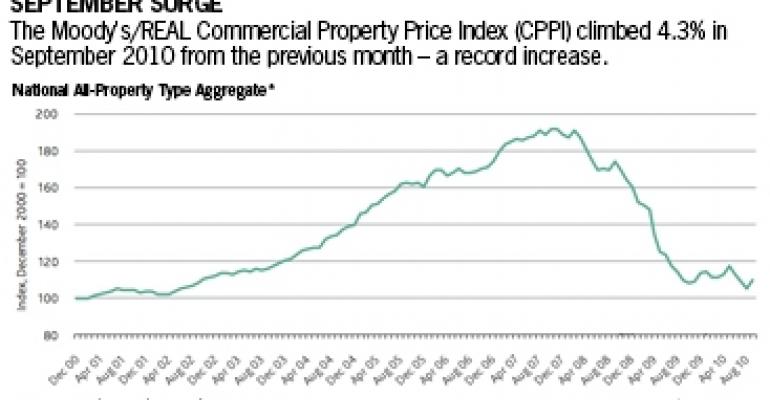U.S. commercial real estate prices climbed 4.3 percent in September from the previous month, according to the Moody’s/REAL Commercial Property Price Indices (CPPI). That’s the largest one-month gain in the index’s nine-year history, and is encouraging for a market that has wrestled with deflated property values for nearly three years now.
Yet experts debate whether the gains will last, or will instead prove to be one in a series of severe fluctuations. The spike is small in relation to the overall, 42.7 percent value decline the index has tracked since the market peaked in October 2007. The CPPI measures transaction price changes for commercial real estate assets based on repeat sales valued at $2.5 million or more.
And there is no guarantee that September’s positive performance will be repeated in a year marked by index volatility. In the first nine months of 2010, the All Property Type Aggregate Index has logged five monthly gains and four monthly declines. In fact, the past year’s ups and downs have nearly balanced out: The All Property Type Aggregate Index was up just 0.3 percent in September from a year ago.

Moody’s analysts chalk up the recent volatility to economic uncertainty and low sales volume. But the changing mix of trading properties is also having an effect on index values, according to Dan Fasulo, managing director at New York-based Real Capital Analytics, which provides the sales data reflected in the Moody’s/REAL Indices.
Many of the assets selling today involve some form of distress, which can result in lower prices than willing sellers would accept, explains Fasulo. Investors, too, are branching away from an exclusive focus on core assets in primary markets to acquire real estate with greater risk profiles and lower prices. “There are lower-quality assets now in the data set and it is causing these pretty violent changes month to month,” says Fasulo.
To continue reading, go to NREIonline.com

